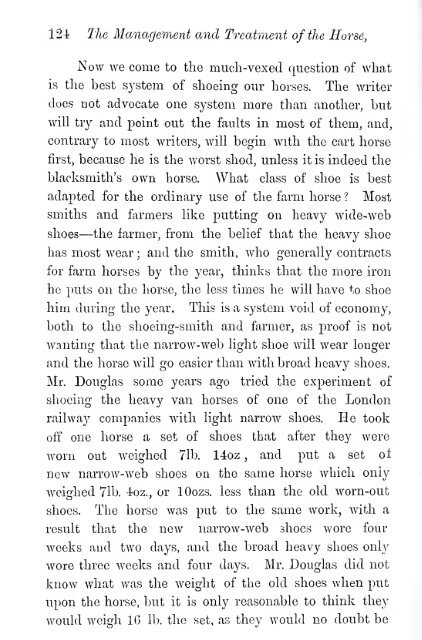The management and treatment of the horse in the stable, field, and ...
The management and treatment of the horse in the stable, field, and ...
The management and treatment of the horse in the stable, field, and ...
You also want an ePaper? Increase the reach of your titles
YUMPU automatically turns print PDFs into web optimized ePapers that Google loves.
124 <strong>The</strong> Management <strong>and</strong> Treatment <strong>of</strong> <strong>the</strong> Horse,<br />
Now we come to <strong>the</strong> much-vexed question <strong>of</strong> what<br />
is <strong>the</strong> best system <strong>of</strong> shoe<strong>in</strong>g our <strong>horse</strong>s. <strong>The</strong> writer<br />
does not advocate one system more than ano<strong>the</strong>r, but<br />
will try <strong>and</strong> po<strong>in</strong>t out <strong>the</strong> faults <strong>in</strong> most <strong>of</strong> <strong>the</strong>m, <strong>and</strong>,<br />
contrary to most writers, will beg<strong>in</strong> with <strong>the</strong> cart <strong>horse</strong><br />
first, because he is <strong>the</strong> worst shod, unless it is <strong>in</strong>deed <strong>the</strong><br />
blacksmith's own <strong>horse</strong>. What class <strong>of</strong> shoe is best<br />
adapted for <strong>the</strong> ord<strong>in</strong>ary use <strong>of</strong> <strong>the</strong> farm <strong>horse</strong> ? Most<br />
smiths <strong>and</strong> farmers like putt<strong>in</strong>g on heavy wide-web<br />
shoes—<strong>the</strong> farmer, from <strong>the</strong> belief that <strong>the</strong> heavy shoe<br />
has most wear ; <strong>and</strong> <strong>the</strong> smith, who generally contracts<br />
for farm <strong>horse</strong>s by <strong>the</strong> year, th<strong>in</strong>ks that <strong>the</strong> more iron<br />
he puts on <strong>the</strong> <strong>horse</strong>, <strong>the</strong> less times he will have to shoe<br />
hirn dur<strong>in</strong>g <strong>the</strong> year. This is a system void <strong>of</strong> economy,<br />
both to <strong>the</strong> shoe<strong>in</strong>g-smith <strong>and</strong> farmer, as pro<strong>of</strong> is not<br />
want<strong>in</strong>g that tlie narrow-web light shoe will wear longer<br />
<strong>and</strong> <strong>the</strong> <strong>horse</strong> will go easier than with broad heavy shoes.<br />
Mr. Douglas some years ago tried <strong>the</strong> experiment <strong>of</strong><br />
shoe<strong>in</strong>g <strong>the</strong> heavy van <strong>horse</strong>s <strong>of</strong> one <strong>of</strong> <strong>the</strong> London<br />
railway companies with light narrow shoes. He took<br />
<strong>of</strong>f one <strong>horse</strong> a set <strong>of</strong> shoes that after <strong>the</strong>y were<br />
worn out weighed 71b. 14oz , <strong>and</strong> put a set o±<br />
new narrow-web shoes on <strong>the</strong> same <strong>horse</strong> which only<br />
weighed 71b. 4oz., or lOozs. less than <strong>the</strong> old worn-out<br />
shoes. <strong>The</strong> <strong>horse</strong> was put to <strong>the</strong> same work, with a<br />
result that <strong>the</strong> new narrow-web shoes wore four<br />
weeks <strong>and</strong> two days, <strong>and</strong> <strong>the</strong> broad heavy shoes only<br />
wore three weeks <strong>and</strong> four days. Mr. Douglas did not<br />
know what was <strong>the</strong> weight <strong>of</strong> <strong>the</strong> old shoes when put<br />
upon <strong>the</strong> <strong>horse</strong>, but it is only reasonable to th<strong>in</strong>k <strong>the</strong>y<br />
would weigh 16 lb. <strong>the</strong> set, as <strong>the</strong>v would no doubt be
















